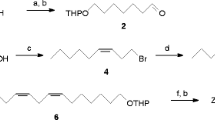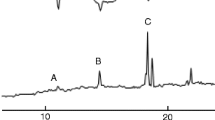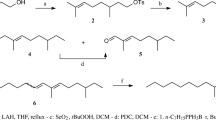Abstract
The major volatile component in the extract of the female sex pheromone gland ofScrobipalpa heliopa was shown to be (E)-3-tridecen-1-ol acetate (V). The identification was based on mass spectral analyses, comparison of retention times with those of synthetic compounds on polar, nonpolar, and liquid crystal gas chromatographic columns and microchemical studies. The latter included hydrolysis and reacetylation, and mass spectral studies of the derivatives formed by epoxidation and methoxymercuration-demercuration. Analysis of gland extracts by gas chromatography linked to electroantennography showed this component to be the only one with significant biological activity, similar to that of the synthetic compound. (E)-3-Tridecenyl acetate (V) attracted male moths to traps in the field while addition of theZ isomer (III) reduced the numbers of moths caught.
Similar content being viewed by others
References
Anon. 1977. Distribution Maps of Insect Pests, Commonwealth Inst. of Entomology, 1977 ed., Series A (Agricultural), Map 276.
Baker, R., Bradshaw, J.W.S., andSpeed, W. 1982. Methoxymercuration-demercuration and mass-spectrometry in the identification of the sex pheromone ofPanolis flammea, the pine beauty moth.Experientia 38:233–234.
Bierl, B.A., Beroza, M., Staten, R.T., Sonnet, P.E., andAdler, V.E. 1974. Pink bollworm sex attractant.J. Econ. Entomol. 67:211–216.
Bierl-Leonhardt, B.A., de Vilbiss, E.D., andPlimmer, J.R. 1980. Location of double-bond position in long-chain aldehydes and acetates by mass spectral analysis of epoxide derivatives.J. Chromatogr. Sci. 18:364–367.
Blomquist, G.J., Howard, R.W., McDaniel, C.A., Remaley, S., Dwyer, L.A., andNelson, D.R., 1980. Application of methoxymercuration-demercuration followed by mass spectrometry as a convenient microanalytical technique for double-bond location in insect-derived alkenes.J. Chem. Ecol. 6:257–269.
Grob, K., andGrob K., Jr. 1978. Splitless injection and the solvent effect.J. High Resolut. Chromatogr. Chromatogr. Commun. 1:57–64.
Hirano, C., Muramoto, H., andHoriike, M. 1976. Sex pheromone produced by female sweet potato leaf roller moth.Naturwissenschaften 63:439.
Horiike, M., andHirano, C. 1982. Identification of double-bond positions in dodecenyl acetates by electron impact mass spectrometry.Agric. Biol. Chem. 46:2667–2672.
Lester, R. 1978. Smectic liquid crystal for the gas-liquid chromatographic separation of lepidopterous sex pheromones and related isomeric olefines.J. Chromatogr. 156:55–62.
Minks, A.K., Roelofs, W.L., Shuurmans-van Dijk, E., Persoons, C.J., andRitter, F.J. 1974. Electroantennogram responses of two tortricid moths using two-component sex pheromones.J. Insect Physiol. 20:1659–1665.
Moorhouse, J.E., Yeadon, R., Beevor, P.S., andNesbitt, B.F. 1969. Method for use in studies of insect chemical communication.Nature 223:1174–1175.
Patel, B.H., andChari, M.S. 1977. The behavior of first instar larva of tobacco stem borer,Gnorimoschema heliopa (Lower).Indian J. Entomol. 37:206–208.
Persoons, C.J., Voerman, S., Verweil, P.E.J., Ritter, F.J., Nooyen, W.J., andMinks, A.K. 1976. Sex pheromone of the potato tuberworm moth,Phthorimaea operculella; isolation, identification and field evaluation.Entomol. Exp. Appl. 20:289–300.
Renou, M., Descoins, C., Lallemand, J.Y., Priesner, E., Lettere, M., andGallois, M., 1980. (E)-3-Dodecenyl acetate, main component of the sex pheromone of the sugar beet moth,Scrobipalpa ocellatella (Boyd) (Lepidoptera: Gelechiidae).Z. Angew. Entomol. 90:275–289.
Roelofs, W.L., andComeau, A. 1970. Lepidopterous sex attractants discovered by field screening tests.J. Econ. Entomol. 63:969–974.
Roelofs, W.L., andComeau, A. 1971. Sex attractants in Lepidoptera, pp. 91–114,in A.S. Tahori (ed.). Pesticide Chemicals.Proc. 2nd Int. Congr. Pestic. Chem. Vol. 3. Gordon and Breach, New York.
Roelofs, W.L., Kochansky, J., Anthon, E., Rice, R., andCardé, R. 1975. Sex pheromone of the peach twig borer moth (Anarsia lineatella). Environ. Entomol. 4:580–582.
Vick, K.W., Su, H.C.F., Sower, L.L., Mahany, P.G., andDrummond, P.G. 1974. (Z,E)-7,11-Hexadecadien-1-ol acetate. Sex pheromone of the Angoumois grain moth,Sitotroga cerealella. Experientia 30:17–18.
Vostrowsky, O., andMichaelis, K. 1981. Methoxymercuration-demercuration of pheromones for double-bond position determination.Z. Naturforsch. B. Org. Chem. 36B:402–404.
Author information
Authors and Affiliations
Rights and permissions
About this article
Cite this article
Baker, R., Herbert, R.H., Neequaye, N.N. et al. Sex pheromone of tobacco stem borer,Scrobipalpa heliopa (Lower) (Lepidoptera: Gelechiidae). J Chem Ecol 11, 989–998 (1985). https://doi.org/10.1007/BF01020669
Received:
Accepted:
Issue Date:
DOI: https://doi.org/10.1007/BF01020669




